
Wine Culture and Information since 2002 - Volume 22
 Wine Culture and Information since 2002 - Volume 22 |
|
Issue 214, February 2022 |
Contents |
|
|
The Law of Monovarietal Wines |
|
More than thirty years have now passed since I started tasting wine, both for pleasure and for professional reasons. And more or less the same time has passed since I started studying enology, sensorial tasting, ampelography and enography, also in this case, for the same reasons. The last subject, in particular – enography, that is the so-called “geography of wine” – has always caught my attention, a virtually endless subject for getting to know the wines of the world, as it is constantly evolving. In fact, enography is the discipline dealing with the study of wines from the wine-growing regions of the world, including the composition of the respective soils, climatic and environmental conditions, viticulture and enological practices, including ampelography, that is the presence and spreading of wine grape varieties in the territories. Furthermore, enography includes the study of the wine legislation of the various countries as well as the denominations and quality classification systems of wines. The study and evaluation of the wine quality classification systems in force in the many countries of the world is always an interesting exercise. Not only does it allow the understanding of the winemaking culture of that country, more specifically, the commercial importance wine represents in every single territory. The study – in particular – is focused on the grape varieties with which the enological production of a country is based, not least its wealth of native and international wine grapes, the latter introduced both for opportunity reasons and for obvious speculation or commercial emulation. In particular, the study of the ampelography of the various wine-growing countries of the world clearly shows – for example – the difference between the main European countries and those of the rest of the world. In the former ones, the production is strongly based on the use of native varieties, in the latter ones on grapes introduced from European countries, in particular, from France and Italy. Not least, it can be found out the impressive ampelographic richness of native varieties of Italy – there are over 500 – placing, in this sense, this country in the top ranking in the world. Moreover, when we begin to study the laws regulating the quality classification systems of the many wine-growing countries of the world, we discover that, in general terms, they all look alike. Some are undeniably more rigorous and strict, others are clearly more permissive and “open”, all – in a more or less similar way – define the concept of quality based on the quantity of grapes in relation to a certain surface of the vineyard, or the yield of grapes in must, always in relation to a delimited area of land. One aspect that has always caught my attention, one of the first things I have always checked every time I started studying the enography of a country, is the definition of “monovarietal” wine. Every time I did that, I have always ended up being perplexed to see how the laws of each country define – in many cases – a monovarietal wine in a way that, in reality, it is not at all. In this regard, I remember my astonishment when I discovered for the first time that many of the production disciplinary of Italian wines allowed the definition of mono-varietal wine in case a single variety was present for at least 85%. Like to say, 15% does not count at all and has no dignity, just a complementary element and which – by magic – turns into another grape. The 15%, if you think about it, is not so little at all. A quantity, although a minor one, which however has the power of altering, often significantly, the sensorial profile of a wine. Let's take, for example, a mono-varietal wine produced with a non-aromatic grape, therefore legally defined as such because of its presence for 85%. Let's add 15% of an aromatic variety to this wine: the sensorial impact, in particular olfactory, is completely altered and, thanks to some kind of magic, that wine expresses, in a rather evident way, bewitching and charming aromas of “grape juice”. As an example, let's imagine a wine produced with 85% Trebbiano Toscano and the remaining 15% Muscat Blanc. In that wine, the expression of Trebbiano Toscano is irremediably covered by that of Muscat Blanc, giving us an “easy” and “direct” wine, with a decidedly pleasing nose. I took this example, so to speak, extreme, in order to better understand what can happen in a mono-varietal wine and, moreover, in a completely legal way. For the sake of completeness, it must be said the complementary quota of 15% – in the disciplinary providing for it – can only be represented by varieties allowed to cultivation in that territory. Furthermore, it must be said in many disciplinary it is explicitly prohibited the use of aromatic varieties. In any case, in many of the Italian denominations the number of varieties allowed for cultivation is usually quite high, therefore – so to speak – the number of tools to alter the monovarietal profile of a wine is decidedly high. The alteration does not obviously affect the olfactory profile only: just think, for example, of the addition of 15% of a round variety such as Merlot, in a wine produced with 85% of Pinot Noir. Another extreme example, however useful to understand how a small quantity of “just” 15% is capable of distorting the character of a wine. Should these considerations lead to think of a criticism of the Italian monovarietal wines and the quality system in force in Italy, it should be noted the same criterion is common and widespread in every wine-growing country of the world. Moreover, in regard to the Italian wine quality classification system, it should be further said that the one in force in Italy is, in many respects, much more strict than that of others. From a purely sensorial point of view, any taster with a minimum of experience would be able to detect the contribution of 15% in a wine from a variety, so to speak, having a strong character, both in aromas and taste. To the less experienced taster, as well as to the not very attentive consumer, that wine will certainly taste more pleasing because of the contribution of the variety present in lesser quantity, however, in both cases, the result is evidently a deception. That alien sensorial profile will inevitably be associated with the main variety, when it does not actually belong to it at all. In legal terms, however, that wine is legitimately considered as monovarietal and represents the pure and immaculate expression of the primary grape. Our ancestors would say: “cui prodest”? (Who benefits?) Of course, all those modest and mediocre wines benefit from it which, with little – just 15% – can wear clothes that are not, and will never be, their own. And this is also definitely beneficial to the potential market opportunities of a wine as, transformed in such a way as to give more pleasing organoleptic qualities, it evidently has a better chance of winning the preferences of consumers. I would like to conclude with a very personal consideration. We talk every day, and not only with regard to wine, to safeguard the identity of a product, to preserve its most typical, traditional expression, as if it were a sort of untouchable sacredness, however we accept to correct the character that nature has granted each grape, in order to make monovarietal what is not monovarietal. For the sake of truth and clarity, it must be said there are many extremely strict production disciplinary and, rightly, for the definition of their monovarietal wines they require the exclusive use of that grape. But in all other cases, is it really necessary to transform the identity of a grape, of a wine, only to please the superficiality of distracted consumers, then hypocritically supporting the role of inflexible and irreducible fighter of the sacred and traditional identity of a territory and its grapes? Yes, inflexible and irreducible, proud defender of the sacred purity. But only for 85%. Antonello Biancalana
|
||||
Contrasts of Franciacorta Satèn and Champagne Blanc de BlancsOnly white berried grapes. This is the only common characteristic in the two wines of this month's tasting by contrast. Two primary representatives of Italian and French enology. |
|
The world of sparkling wines, undeniably, always arouses a particular interest from most of wine lovers. The joyful sparkling bubbles that dancing in the glasses – since the time when sparkling wines had been started to be produced with the classic method – have always had a particular charm. Wines protagonists of the most significant celebrations, the uncorking of a bottle of sparkling wine always represents the highest moment of a meeting or banquet. This role, historically recognized to sparkling wines, has undeniably represented, so to speak, an enormous limitation, as – in general terms – it represents the main cause of its limited consumption. Relegated to parties and anniversaries, at the end of important banquets – sometimes served as apéritif – sparkling wines see their greatest success and consumption on the occasion of the main holidays of the year. A trend that, fortunately, has been changing in recent years and their consumption – finally – is also considered in the pairing of an entire meal. The world of sparkling wines, however, has always been capable of offering a wide choice of styles, undeniably suitable for food pairing, from apéritifs to desserts. In some cases, even for meditation. The two leading sparkling wine producing countries in the world – France and Italy – can, on their own, offer a wide choice of styles and production methods, certainly perfect for pairing with a vast amount of dishes and foods. Franciacorta and Champagne, in particular, are produced in a rich and vast choice of styles, including those made from white grape varieties only. In fact, this month's tasting by contrast will examine two bottles belonging to this category, although the composition of the grapes and the enological characteristics differ in certain aspects. In addition to this – of course – these are two production areas characterized by very different environmental and climatic conditions, a factor that significantly affects the final result, even when the production makes use of the same grapes.
|
|
Among the primary wine-growing areas of Italy committed to the production of sparkling wines with the classic method, Franciacorta has built over time an image and a solid reputation recognized worldwide. A result achieved thanks to the search for quality – proved with facts and with their wines – and the establishment of a winning model of collective representation which involved local producers. The relationship of Franciacorta with effervescent wines is decidedly long as well as documented, however the creation of the enological model we know today – of wines produced with the classic method of the refermentation in bottle – dates back to the early 1960s. In that period, the supremacy of Champagne was undisputed, a historically important position and which for centuries has been the reference model for sparkling wines refermented in bottle. The same can be said for the grapes that were used everywhere in the world for the production of this style of wines, with the aim of emulating the success of Champagne. The varieties used for the production of the many styles of Franciacorta are in fact Chardonnay, Pinot Noir and Pinot Blanc, grapes notoriously of French origin, more specifically, from Burgundy, not far from Champagne. These are in fact varieties which are allowed for the production of the famous French wine. Of these, Pinot Blanc – which today represents a decidedly marginal percentage in Champagne – is actually a significant variety in Franciacorta, capable of giving the wines of this territory an extraordinary personality. A style characterizing Franciacorta is undeniably the Satèn, a wine providing for the exclusive use of white grape varieties, specifically at least 50% of Chardonnay and the remaining part of Pinot Blanc. Moreover, compared to the other styles of Franciacorta, Satèn is produced exclusively in the brut style and the refermentation pressure inside the bottle must be less than 5 atmospheres. The result is a wine having a unique character, with a velvety and creamy taste profile, qualities that are at the origin of its name, ideally “soft as silk”. Finally, according to the production disciplinary, Franciacorta Satèn provides for a minimum period of 24 months of refermentation and bottle aging in its own yeasts, a period set to 60 months for the Riserva style.
|
||||
|
Champagne wines have a very long and very successful history all over the world. The bubbles of these famous wines represent a solid and historical commercial success, started in the second half of 1600 when in the Benedictine abbey of Hautvillers – thanks to the work of the famous monk Dom Pierre Pérignon – and the history of modern Champagne began. Contrary to popular belief, the famous French monk did not invent the method of the refermentation in bottle. In fact, there are several proofs and documents proving the existence and use of this technique in periods decidedly prior to the era of Dom Pérignon, not least, in use in Benedictine convents in Italy, order to which the famous French monk belonged. In this regard, we can mention at least two cases of citations prior to 1650: the book written by doctor Gerolamo Conforti from Brescia, entitled “Libellus de Vino Mordaci” – (Booklet about sparkling wines) published in 1570 – and the one of doctor Francesco Scacchi from Fabriano who in 1622 published his “De Salubri Potu Dissertatio” (Dissertation on healthy drinking). Origins and merits aside, Champagne wines are still today among the sparkling wines produced with the refermentation in bottle method to have the greatest success worldwide. A success – without a shadow of a doubt – determined both by the undeniable quality and by the very particular environmental and climatic conditions that make Champagne a unique wine land of its kind. The famous sparkling wines of this area are mainly produced with Pinot Noir, Pinot Meunier and Chardonnay, however the production disciplinary also provides for the use of Arbanne, Petit Meslier, Pinot Blanc and Pinot Gris grape varieties. In this regard, it should be noted that these last four varieties now represent a minimal and marginal percentage – less than 0.3% of the total – and almost all Champagne is produced with the first three varieties. The wine we will examine for our tasting by contrast belongs to the Blanc de Blancs style, that is exclusively produced with white berried grapes, therefore – by considering the current viticultural situation of Champagne – exclusively produced with Chardonnay. Finally, it should be noted that, according to the production disciplinary, non-vintage Champagne – the so-called sans année – requires a minimum period of refermentation in bottle and subsequent aging on its lees for at least 15 months, a period set at 3 years for the vintage ones.
|
Before pouring the wines of our tasting by contrast into the glasses, we will search for the two bottles we are going to examine. Given the huge popularity of these wines, the search will not be difficult as both Franciacorta and Champagne are widely available on the shelves of wine shops. Although they can be easily found, we will however have to make sure they belong to the styles we will examine in our tasting. We therefore make sure Franciacorta belongs to the Satèn style and the Champagne to Blanc de Blancs. As for Franciacorta, the choice is simple as the name of the style is always shown on the label, while for Champagne the belonging to the Blanc de Blancs style is not always indicated. In this case, we need to specifically know the bottle before buying it. As far as the composition of the grapes is concerned, the Franciacorta Satèn we will choose must be mainly produced with Chardonnay – about 75% – and the remaining part of Pinot Blanc. As for Champagne Blanc de Blancs, although the disciplinary provides for the use of five white berried grapes, we will have the certainty our bottle is produced with Chardonnay only, given its popularity. The wines we will pour into our tasting glasses – at a temperature of 10 °C (50 °F) – must be “non vintage”, therefore belonging to the so-called sans année category. Let's pour the Franciacorta Satèn and Champagne Blanc de Blancs into the glasses and start this month's tasting by contrast. The first wine we will examine is Franciacorta Satèn and, by holding the glass in vertical position, we evaluate the quality of the effervescence of the wine, in particular the development and size of the bubbles, the so-called perlage. The size of the bubbles is very small, with a continuous and persistent development towards the surface. The crown – the thin ring of froth that forms on the surface around the walls of the glass – has fine, small and creamy bubbles. Let's tilt the glass over a white surface and, by observing the base, we evaluate the color. Franciacorta Satèn shows a brilliant straw yellow and high transparency. The nuance, observed at the edge of the wine, towards the opening of the glass, shows a greenish yellow color. Let's now pass to the evaluation of the appearance of Champagne Blanc de Blancs and, by holding the glass in vertical position, we observe the development of the perlage. Also in this case the size of the bubbles is very small and the development towards the surface of the glass is continuous and persistent. The crown, observed from the top of the glass, is consistent and with small bubbles. The color of Champagne Blanc de Blancs is bright straw yellow and, like the previous wine, with a high transparency. The nuance is intense straw yellow, decidedly darker than Franciacorta Satèn. The characteristic of being produced with the method of the refermentation in bottle and the use of white berried grapes – in particular, Chardonnay – could suggest these wines share similar olfactory qualities. Indeed, Franciacorta Satèn and Champagne Blanc de Blancs express very different olfactory profiles on the nose. In fact, there are many elements influencing the organoleptic result of sparkling wines and which must be considered, as well as the differences in the composition of the soil, the environmental factors and climatic conditions of the respective territories. In particular, when evaluating sparkling wines – especially those produced with the classic method, that is the refermentation in bottle – we must consider the remarkable impact of man, specifically the particular wine making practices typical of the production of sparkling wines. Two of these factors, capable of significantly altering the organoleptic profile of these wines, are the liqueur de tirage and liqueur d'expedition. These two blends, respectively added before the refermentation in bottle and after disgorgement, represent in all respects a specific and, so to speak, secret “recipe” of each producer. They are, to all intents and purposes, identification trademarks and which distinguish the wines of each producer. Let's continue the tasting by contrast and proceed with the evaluation of the olfactory profiles of the two wines, starting – as in the previous phase – from Franciacorta Satèn. By holding the glass in vertical position, without swirling, let's proceed with the first smell in order to evaluate the opening of the wine, that is the primary and identifying olfactory qualities. On the nose we perceive, intense and clean, pleasing aromas of banana, acacia, apple and bread crust, the latter given, in particular, by the specific production of the refermentation in bottle. Let's now swirl the glass – an operation favoring the oxygenation of the wine and therefore the development of the other aromas – and let's proceed with the second smell. Franciacorta Satèn completes the olfactory profile with hawthorn, pear, plum and grapefruit, as well as aromas reminiscent of citrus and hazelnut, the latter generally also attributable to Pinot Blanc. Let's now pass to the evaluation of the opening of Champagne Blanc de Blancs and, by holding the glass in vertical position, let's proceed with the first smell. The French wine can be appreciated for its aromas of acacia, banana, honeysuckle and a pleasant aroma of croissant. After having swirled the glass, Champagne Blanc de Blancs completes its profile with pear, lime, hawthorn, bergamot, grapefruit and bread crust, often followed by the aroma of praline. Let's now pass to the evaluation of the gustatory profiles of Franciacorta Satèn and Champagne Blanc de Blancs. The first organoleptic quality we will examine is the attack, that is the initial sensation the wine develops in the mouth at the first sip. Let's start with the evaluation of the attack of Franciacorta Satèn and then take a sip of this wine: the famous Italian sparkling wine expresses in the mouth an intense sensation of crispness and pleasing effervescence, almost creamy, not excessively strong. We can perceive flavors of apple, banana, pear and grapefruit, confirming the good correspondence to the nose. Note the effect of alcohol, decidedly moderate, however enough to balance the intensity of the effervescence and the crispness given by the acidity. Let's now pass to the evaluation of the attack of Champagne Blanc de Blancs and take a sip of this wine. The French sparkling wine can be appreciated in the mouth for the clear effervescence and pleasing crispness given by the acidity, with a rounder character than Franciacorta Satèn. The effervescence of Champagne is more aggressive than the Italian sparkling wine, however perfectly balanced by the effect of alcohol. In the mouth can also be perceived flavors of banana, pear, bergamot and praline. Let's end this month's tasting by contrast by proceeding with the evaluation of the final sensations Franciacorta Satèn and Champagne Blanc de Blancs leave in the mouth after swallowing. In particular, we will evaluate the taste-olfactory persistence, that is the time during which the gustatory and olfactory sensations of the wine can be perceived after swallowing, a primary factor in the quality of a wine. The finish of Franciacorta Satèn is persistent and in the mouth can be still perceived intense and pleasing flavors of banana, apple, pear and grapefruit, with the sensation of crispness in primary evidence. The finish of Champagne Blanc de Blancs is also persistent – in both wines it can be easily counted over ten seconds – and in the mouth are perceived the flavors of banana, pear, grapefruit and praline. Moreover, also the sensation of crispness is well perceptible and – compared to Franciacorta Satèn – a stronger sensation of roundness is perceived as well. Finally, let's place the glasses side to side and proceed with a last smell, first the Franciacorta Satèn and then the Champgane Blanc de Blancs: the olfactory difference – despite the common presence of Chardonnay – is decidedly distant.
|
||||||||
Wines of the Month |
|
|
|
Score legend Prices are to be considered as indicative. Prices may vary according to the country or the shop where wines are bought |
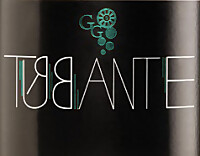
|
|
Erbaluce di Caluso Spumante Metodo Classico Pas Dosè Turbante 2016 |
|
| Gnavi Carlo (Piedmont, Italy) | |
 Erbaluce Erbaluce | |
| Price: € 25.00 | Score: |
 Brilliant golden yellow and nuances of golden yellow, very transparent,
fine and persistent perlage, Brilliant golden yellow and nuances of golden yellow, very transparent,
fine and persistent perlage,
 Intense, clean, pleasing, refined and elegant, starts with hints of
apple, plum and bread crust followed by aromas of hawthorn, chamomile,
citron, pear, plum, hazelnut, thyme, yeast and mineral. Intense, clean, pleasing, refined and elegant, starts with hints of
apple, plum and bread crust followed by aromas of hawthorn, chamomile,
citron, pear, plum, hazelnut, thyme, yeast and mineral.
 Effervescent and crisp attack, however balanced by alcohol, good body,
intense flavors, agreeable. Effervescent and crisp attack, however balanced by alcohol, good body,
intense flavors, agreeable.
 Persistent finish with flavors of apple, plum and citron. Persistent finish with flavors of apple, plum and citron. Refermented in bottle and aged on its lees for at least 48 months. Refermented in bottle and aged on its lees for at least 48 months. |
|
 Stuffed pasta with mushrooms, Roasted white meat, Roasted fish, Mushroom soups, Legume soups Stuffed pasta with mushrooms, Roasted white meat, Roasted fish, Mushroom soups, Legume soups |
|
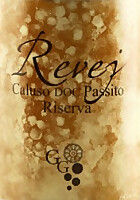
|
|
Erbaluce di Caluso Passito Riserva Revej 2007 |
|
| Gnavi Carlo (Piedmont, Italy) | |
 Erbaluce Erbaluce | |
| Price: € 28.00 - 50cl | Score: |
 Deep amber yellow and nuances of amber yellow, transparent. Deep amber yellow and nuances of amber yellow, transparent. Intense, clean, pleasing, refined and elegant, starts with hints of
raisin, dried fig and hazelnut followed by aromas of dried apricot, date,
caramel, candied fruits, chestnut honey, citrus fruit peel, licorice,
walnut husk, leather and nail polish. Intense, clean, pleasing, refined and elegant, starts with hints of
raisin, dried fig and hazelnut followed by aromas of dried apricot, date,
caramel, candied fruits, chestnut honey, citrus fruit peel, licorice,
walnut husk, leather and nail polish.
 Sweet and round attack, however balanced by alcohol, full body, intense
flavors, pleasing crispness. Sweet and round attack, however balanced by alcohol, full body, intense
flavors, pleasing crispness.
 Persistent finish with flavors of raisin, dried fig, date and chestnut
honey. Persistent finish with flavors of raisin, dried fig, date and chestnut
honey.
 10 years in steel and cement tanks, 1 year in bottle. 10 years in steel and cement tanks, 1 year in bottle. |
|
 Hard and piquant cheese, Dried fruit tarts Hard and piquant cheese, Dried fruit tarts |
|

|
|
Ishopu 2019 |
|
| Antonio Mele (Sardinia, Italy) | |
 Cannonau Cannonau | |
| Price: € 20.00 | Score: |
 Intense ruby red and nuances of ruby red, little transparency. Intense ruby red and nuances of ruby red, little transparency. Intense, clean, pleasing and refined, starts with hints of plum, black
cherry and dried violet followed by aromas of raspberry, blackberry, carob,
walnut husk and vanilla. Intense, clean, pleasing and refined, starts with hints of plum, black
cherry and dried violet followed by aromas of raspberry, blackberry, carob,
walnut husk and vanilla.
 Properly tannic attack and however balanced by alcohol, good body,
intense flavors, agreeable. Properly tannic attack and however balanced by alcohol, good body,
intense flavors, agreeable.
 Persistent finish with flavors of plum, black cherry and raspberry. Persistent finish with flavors of plum, black cherry and raspberry. 12 months in cask. 12 months in cask. |
|
 Pasta with meat and mushrooms, Stewed meat with mushrooms, Broiled meat Pasta with meat and mushrooms, Stewed meat with mushrooms, Broiled meat |
|

|
|
Cannonau di Sardegna Riserva Vinera 2017 |
|
| Antonio Mele (Sardinia, Italy) | |
 Cannonau Cannonau | |
| Price: € 40.00 | Score: |
 Deep ruby red and nuances of garnet red, little transparency. Deep ruby red and nuances of garnet red, little transparency. Intense, clean, pleasing, refined and elegant, starts with hints of
plum, black cherry and dried violet followed by aromas of blackberry,
blueberry, raspberry, tobacco, cocoa, carob, licorice, vanilla and menthol. Intense, clean, pleasing, refined and elegant, starts with hints of
plum, black cherry and dried violet followed by aromas of blackberry,
blueberry, raspberry, tobacco, cocoa, carob, licorice, vanilla and menthol.
 Properly tannic attack and however balanced by alcohol, full body,
intense flavors, agreeable. Properly tannic attack and however balanced by alcohol, full body,
intense flavors, agreeable.
 Persistent finish with flavors of plum, black cherry and blackberry. Persistent finish with flavors of plum, black cherry and blackberry. 18 months in cask, 12 months in bottle. 18 months in cask, 12 months in bottle. |
|
 Game, Roasted meat, Stewed and braised meat, Hard cheese Game, Roasted meat, Stewed and braised meat, Hard cheese |
|
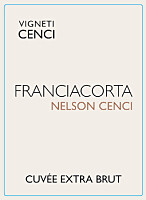
|
|
Franciacorta Extra Brut Nelson Cenci 2012 |
|
| La Boscaiola Vigneti Cenci (Lombardy, Italy) | |
 Chardonnay (80%), Pinot Bianco (20%) Chardonnay (80%), Pinot Bianco (20%) | |
| Price: € 31.20 | Score: |
 Intense straw yellow and nuances of golden yellow, very transparent,
fine and persistent perlage. Intense straw yellow and nuances of golden yellow, very transparent,
fine and persistent perlage.
 Intense, clean, pleasing, refined and elegant, starts with hints of
apple, banana and bread crust followed by aromas of acacia, hawthorn,
grapefruit, pear, citron, plum, honey, hazelnut, butter and croissant. Intense, clean, pleasing, refined and elegant, starts with hints of
apple, banana and bread crust followed by aromas of acacia, hawthorn,
grapefruit, pear, citron, plum, honey, hazelnut, butter and croissant.
 Effervescent and crisp attack, however balanced by alcohol, good body,
intense flavors, agreeable. Effervescent and crisp attack, however balanced by alcohol, good body,
intense flavors, agreeable.
 Persistent finish with flavors of apple, banana and grapefruit. Persistent finish with flavors of apple, banana and grapefruit. Refermented in bottle and aged on its lees for at least 48 months. Refermented in bottle and aged on its lees for at least 48 months. |
|
 Pasta with fish and mushrooms, Stewed fish with mushrooms, Roasted white meat, Mushroom soups, Legume soups Pasta with fish and mushrooms, Stewed fish with mushrooms, Roasted white meat, Mushroom soups, Legume soups |
|
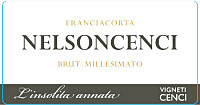
|
|
Franciacorta Brut Nelson Cenci "L'Insolita Annata" 2011 |
|
| La Boscaiola Vigneti Cenci (Lombardy, Italy) | |
 Chardonnay (70%), Pinot Bianco (20%), Pinot Nero (10%) Chardonnay (70%), Pinot Bianco (20%), Pinot Nero (10%) | |
| Price: € 41.40 | Score: |
 Brilliant straw yellow and nuances of straw yellow, very transparent,
fine and persistent perlage. Brilliant straw yellow and nuances of straw yellow, very transparent,
fine and persistent perlage.
 Intense, clean, pleasing, refined and elegant, starts with hints of
apple, plum and bread crust followed by aromas of hawthorn, grapefruit,
tangerine, pear, citron, pineapple, croissant, honey, butter, hazelnut and
mineral. Intense, clean, pleasing, refined and elegant, starts with hints of
apple, plum and bread crust followed by aromas of hawthorn, grapefruit,
tangerine, pear, citron, pineapple, croissant, honey, butter, hazelnut and
mineral.
 Effervescent and crisp attack, however balanced by alcohol, good body,
intense flavors, agreeable. Effervescent and crisp attack, however balanced by alcohol, good body,
intense flavors, agreeable.
 Persistent finish with flavors of apple, plum and grapefruit. Persistent finish with flavors of apple, plum and grapefruit. Refermented in bottle and aged on its lees for at least 50 months. Refermented in bottle and aged on its lees for at least 50 months. |
|
 Stuffed pasta with mushrooms, Roasted fish, Stewed meat with mushrooms, Legume soups, Mushroom soups Stuffed pasta with mushrooms, Roasted fish, Stewed meat with mushrooms, Legume soups, Mushroom soups |
|
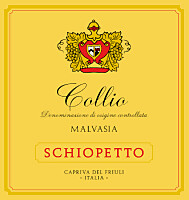
|
|
Collio Malvasia 2019 |
|
| Schiopetto (Friuli-Venezia Giulia, Italy) | |
 Malvasia Istriana Malvasia Istriana | |
| Price: € 25.00 | Score: |
 Brilliant straw yellow and nuances of straw yellow, very transparent. Brilliant straw yellow and nuances of straw yellow, very transparent. Intense, clean, pleasing, refined and elegant, starts with hints of
apple, plum and peach followed by aromas of hawthorn, broom, jasmine, pear,
citrus fruits, pineapple, almond and flint. Intense, clean, pleasing, refined and elegant, starts with hints of
apple, plum and peach followed by aromas of hawthorn, broom, jasmine, pear,
citrus fruits, pineapple, almond and flint.
 Crisp attack and however balanced by alcohol, good body, intense
flavors, agreeable. Crisp attack and however balanced by alcohol, good body, intense
flavors, agreeable.
 Persistent finish with flavors of apple, plum and peach. Persistent finish with flavors of apple, plum and peach. 8 months in steel tanks, at least 5 months in bottle. 8 months in steel tanks, at least 5 months in bottle. |
|
 Fish and crustacean appetizers, Pasta with fish and crustaceans, Sauteed fish Fish and crustacean appetizers, Pasta with fish and crustaceans, Sauteed fish |
|
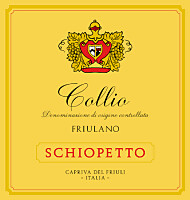
|
|
Collio Friulano 2019 |
|
| Schiopetto (Friuli-Venezia Giulia, Italy) | |
 Friulano Friulano | |
| Price: € 25.00 | Score: |
 Brilliant straw yellow and nuances of straw yellow, very transparent. Brilliant straw yellow and nuances of straw yellow, very transparent. Intense, clean, pleasing, refined and elegant, starts with hints of
apple, pear and peach followed by aromas of hawthorn, white rose, broom,
elder flower, pineapple, citrus fruits, plum, thyme, almond and mineral. Intense, clean, pleasing, refined and elegant, starts with hints of
apple, pear and peach followed by aromas of hawthorn, white rose, broom,
elder flower, pineapple, citrus fruits, plum, thyme, almond and mineral.
 Crisp attack and however balanced by alcohol, good body, intense
flavors, agreeable. Crisp attack and however balanced by alcohol, good body, intense
flavors, agreeable.
 Persistent finish with flavors of apple, pear and peach. Persistent finish with flavors of apple, pear and peach. 8 months in steel tanks, at least 5 months in bottle. 8 months in steel tanks, at least 5 months in bottle. |
|
 Pasta and risotto with fish, Stewed fish, Sauteed white meat, Vegetable flans, Dairy products Pasta and risotto with fish, Stewed fish, Sauteed white meat, Vegetable flans, Dairy products |
|
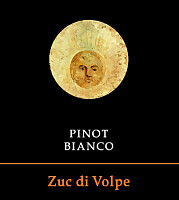
|
|
Colli Orientali del Friuli Pinot Bianco Zuc di Volpe 2019 |
|
| Volpe Pasini (Friuli-Venezia Giulia, Italy) | |
 Pinot Bianco Pinot Bianco | |
| Price: € 25.50 | Score: |
 Brilliant straw yellow and nuances of straw yellow, very transparent. Brilliant straw yellow and nuances of straw yellow, very transparent. Intense, clean, pleasing, refined and elegant, starts with hints of
apple, plum and hawthorn followed by aromas of acacia, white rose,
broom, lemon, pear, pineapple, peach, grapefruit, hazelnut and mineral. Intense, clean, pleasing, refined and elegant, starts with hints of
apple, plum and hawthorn followed by aromas of acacia, white rose,
broom, lemon, pear, pineapple, peach, grapefruit, hazelnut and mineral.
 Crisp attack and however balanced by alcohol, good body, intense
flavors, agreeable. Crisp attack and however balanced by alcohol, good body, intense
flavors, agreeable.
 Persistent finish with flavors of apple, plum and lemon. Persistent finish with flavors of apple, plum and lemon. Aged in steel tanks. Aged in steel tanks. |
|
 Pasta with fish and crustaceans, Sauteed fish, Sauteed white meat, Fried fish, Dairy products Pasta with fish and crustaceans, Sauteed fish, Sauteed white meat, Fried fish, Dairy products |
|
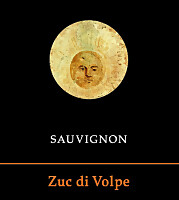
|
|
Colli Orientali del Friuli Sauvignon Zuc di Volpe 2020 |
|
| Volpe Pasini (Friuli-Venezia Giulia, Italy) | |
 Sauvignon Blanc Sauvignon Blanc | |
| Price: € 25.50 | Score: |
 Brilliant greenish yellow and nuances of greenish yellow, very
transparent. Brilliant greenish yellow and nuances of greenish yellow, very
transparent.
 Intense, clean, pleasing, refined and elegant, starts with hints of
gooseberry, peach and elder flower followed by aromas of acacia, broom
citron, pear, pineapple, apple, plum, nettle, bell pepper, sage and
mineral. Intense, clean, pleasing, refined and elegant, starts with hints of
gooseberry, peach and elder flower followed by aromas of acacia, broom
citron, pear, pineapple, apple, plum, nettle, bell pepper, sage and
mineral.
 Crisp attack and however balanced by alcohol, good body, intense
flavors, agreeable. Crisp attack and however balanced by alcohol, good body, intense
flavors, agreeable.
 Very persistent finish with long flavors of gooseberry, peach and
citron. Very persistent finish with long flavors of gooseberry, peach and
citron.
 Aged in steel tanks. Aged in steel tanks. |
|
 Crustacean appetizers, Fried fish, Risotto with crustaceans and vegetables, Dairy products Crustacean appetizers, Fried fish, Risotto with crustaceans and vegetables, Dairy products |
|
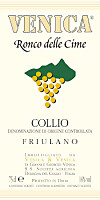
|
|
Collio Friulano Ronco delle Cime 2020 |
|
| Venica (Friuli-Venezia Giulia, Italy) | |
 Friulano Friulano | |
| Price: € 28.00 | Score: |
 Intense straw yellow and nuances of straw yellow, very transparent. Intense straw yellow and nuances of straw yellow, very transparent. Intense, clean, pleasing, refined and elegant, starts with hints of
apple, pear and medlar followed by aromas of hawthorn, chamomile, broom,
peach, plum, citrus fruits, pineapple, hay, thyme and almond. Intense, clean, pleasing, refined and elegant, starts with hints of
apple, pear and medlar followed by aromas of hawthorn, chamomile, broom,
peach, plum, citrus fruits, pineapple, hay, thyme and almond.
 Crisp attack and however balanced by alcohol, good body, intense
flavors, pleasing roundness. Crisp attack and however balanced by alcohol, good body, intense
flavors, pleasing roundness.
 Persistent finish with flavors of apple, pear and medlar. Persistent finish with flavors of apple, pear and medlar. 6 months in cask and in steel tanks. 6 months in cask and in steel tanks. |
|
 Pasta and risotto with fish and crustaceans, Stewed fish with mushrooms, Fried fish, Broiled crustaceans, Mushroom soups Pasta and risotto with fish and crustaceans, Stewed fish with mushrooms, Fried fish, Broiled crustaceans, Mushroom soups |
|
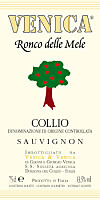
|
|
Collio Sauvignon Ronco delle Mele 2020 |
|
| Venica (Friuli-Venezia Giulia, Italy) | |
 Sauvignon Blanc Sauvignon Blanc | |
| Price: € 37.00 | Score: |
 Brilliant straw yellow and nuances of straw yellow, very transparent. Brilliant straw yellow and nuances of straw yellow, very transparent. Intense, clean, pleasing, refined and elegant, starts with hints of
gooseberry, passion fruit and peach followed by aromas of elder flower,
broom, pineapple, pear, citron, apple, lychee, grapefruit, nettle, bell
pepper, sage and thyme. Intense, clean, pleasing, refined and elegant, starts with hints of
gooseberry, passion fruit and peach followed by aromas of elder flower,
broom, pineapple, pear, citron, apple, lychee, grapefruit, nettle, bell
pepper, sage and thyme.
 Crisp attack and however balanced by alcohol, good body, intense
flavors, agreeable. Crisp attack and however balanced by alcohol, good body, intense
flavors, agreeable.
 Very persistent finish with long flavors of gooseberry, passion fruit
and peach. Very persistent finish with long flavors of gooseberry, passion fruit
and peach.
 5 months, part in cask, part in steel tanks. 5 months, part in cask, part in steel tanks. |
|
 Pasta and risotto with fish and crustaceans, Sauteed fish with mushrooms, Mushroom soups, Sauteed white meat Pasta and risotto with fish and crustaceans, Sauteed fish with mushrooms, Mushroom soups, Sauteed white meat |
|
News |
|
In this section are published news and information about events concerning the world of wine and food. Whoever is interested in publishing this kind of information can send us a mail to our address.
|
AquavitaeReview of Grappa, Distillates and Brandy |
|
|
||||||||||||
Wine Guide ParadeNovember 2021
|
| |||||||
Privacy Policy | |||||||


| Copyright © 2002-2024 Antonello Biancalana, DiWineTaste - All rights reserved |
| All rights reserved under international copyright conventions. No part of this publication and of this WEB site may be
reproduced or utilized in any form or by any means, electronic or mechanical, without permission in writing from DiWineTaste. |